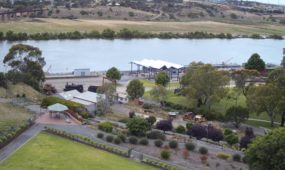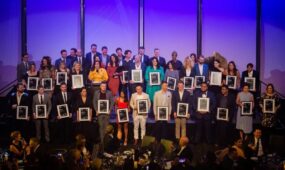Bioinformatics points the way to cancer's genetic causes
Uncategorized
A RELUCTANT biologist at the University of South Australia is using computer science and mathematics to shortlist the genes and gene regulators that cause cancer to spread.

Sign up to receive notifications about new stories in this category.
Thank you for subscribing to story notifications.
A RELUCTANT biologist at the University of South Australia is using computer science and mathematics to shortlist the genes and gene regulators that cause cancer to spread.
Research Fellow Thuc Le won the 2015 Ian Davey Thesis Prize for the most outstanding PhD thesis across the University. His work applied bioinformatics to investigate how genes and gene regulators, called microRNA, interact and lead to cancer.
“Bioinformatics is a multidisciplinary field,” Le says, “It combines mathematics, statistics and computer science to solve biology problems. It's popular in the US but relatively new in Australia.”
Le is originally from Vietnam, where he holds a bachelor and masters degree in pure mathematics. He was a high school teacher for five years before moving to Adelaide to pursue his Bachelor and PhD in Computer Science.
“The hard thing for me is biology. Honestly, I don't like it. In high school, the two things I hated were biology first and English second. I hate writing in English. So now my main job is to write in English about biology – that's terrible,” he says, laughing.
“We have a very good recipe for collaboration. It's a complete procedure, from computer predictions to wet lab validation.”
Since bioinformatics is a relatively young field, Le thinks biologists don't always give it the attention it deserves, preferring to rely on wet lab experiments alone.
He has been working closely with the Centre for Cancer Biology (CCB) who, luckily, are likeminded collaborators.
“We have a very good recipe for collaboration. They raise the biological problems and we design the computational model to solve that problem. We send them all the prediction results and they follow up with wet lab experiments. It's a complete procedure, from computer predictions to wet lab validation.”
Rather than look at cancer like a disease, Le's model approaches it as a collection of processes.
“It's the process of creating new cells, the process of dividing a cell without stopping, and the process of spreading the tumour to nearby tissue. Each process involves hundreds of genes. Not just one or two that researchers will look for,” Le explains.
“We know about a class of gene regulators called microRNA, they control the activity of other genes. We need to know the functions of the microRNA, that's the most important thing.”
Le's collaborators at the CBB have found a group of microRNA that control the process of metastasis, the spreading of cancer to nearby tissue. They won't kill cancer if they manage to knock out the microRNA responsible for metastasis, but they will stop it in its tracks.
“What they need to try and do is knock out one microRNA at a time and measure the activity of other genes. If a gene's activity changes significantly, then they think that gene will be the target of the microRNA. But we have thousands of microRNA to test and wet lab experiments are very costly.”
This is where bioinformatics thrives. Computer models can handle the large amounts of data required to shortlist the microRNA.
“That's what I did – develop computational methods to predict and shortlist only the highly confident interactions between micro RNA and genes. Then we send the prediction to the CCB and they follow up with those shortlisted interactions.”
Le says this kind of work has been done before, but the innovation in his work is looking for the causal relationship between microRNA and genes, rather than just statistical correlations.
“Firstly we build an interacting network between the microRNA and genes. You can imagine that if they're predicted to be the microRNA regulated gene, we put a link between them. In the end we have a very large net. Then we hold the microRNA in our hand, we shake the net and see which part of the net changes. The gene that changes will be the target of the microRNA.”
He says that causality has been very successful in economics and other fields – it's won two Nobel prizes in economics – but hasn't been applied in biology.
“Our methods aren't very new, but my job is to adapt these methods from economics and apply that work to the biological problems. Luckily the experiment results support our model,” Le says.
Since completing his PhD and winning the Ian Davey Thesis Prize, Le has taken on students of his own to help with his work.
“It was very good news when I won the prize. I couldn't work all day. More importantly, it's recognition that bioinformatics is an important research area. They liked the multi-disciplinary approach we take.
“It's not just the work that's important, but the mindset. If biologists and other researchers like mathematicians can work on a larger scale of research, that will be very good. They'll come up with very good results, rather than just focusing on their own lab and their own thing.”
The scope of Le's work seems set to expand greatly. He says his original computational model is something of a demonstration. The end result of his work was mostly left to the CCB, though he will now work more closely with them to help design the wet lab experiments that follow his predictions.
In truth, microRNA are not the only regulators of genes, and this is where Le thinks his work will be heading in the immediate future.
“Using modern technology to do gene sequencing, researchers have found multiple types of gene regulators. There's a transcription regulator, some sort of protein, there's a long, non-coding RNA. And a lot of other stuff that I don't remember,” Le says.
Le's original work, it seems, is just part of a complete picture. Now there are multiple players involved. Perhaps the relationships he predicted are actually controlled by another regulator.
“The problem has become more complex and no sort of wet lab experiment can find that relationship – they need computer science research to at least isolate some subnetworks for them and then they can experiment with just these small parts.”
“What motivates me is the problem we're working on. If we can help find the causes of cancer, that would help with the process of designing effective treatment therapies. Around 10 million people are dying every year, more than 20,000 a day.”
Jump to next article



